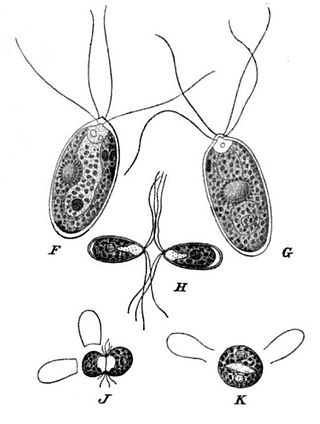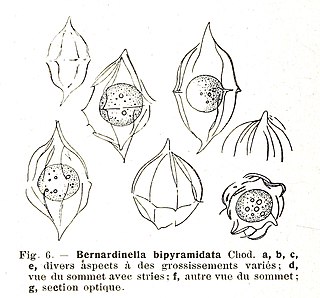Ankyra is a genus of green algae in the family Characiaceae. This genus of algae is closely related to Atractomorpha and Sphaeroplea. They are found in stagnant waters.

Carteria is a genus of green algae in the family Chlamydomonadaceae. Carteria are similar in morphology to the common genus Chlamydomonas and differ by having four, rather than two, flagella at the vegetative stage.
Dicloster is a genus of green algae in the family Chlorellaceae, containing the sole species Dicloster acuatus. It is found in freshwater habitats as plankton, and is distributed around the world.

Lagerheimia is a genus of green algae in the family Oocystaceae. It is commonly found in freshwater habitats all over the world, although some species are rare and have only been recorded from Europe or the United States.

Micractinium is a genus of green algae in the family Chlorellaceae. Species of the genus Micractinium are common in freshwater habitats. A few species are found as endosymbionts of protozoa, such as Micractinium conductrix and Micractinium tetrahymenae.
Palmellopsis is a genus of green algae, specifically of the Palmellopsidaceae. They are either planktonic or attached to substrates in fresh water, or in aeroterrestrial habitats.

Paulschulzia is a genus of green algae, specifically of the family Tetrasporaceae.
Polyedriopsis is a genus of green algae in the order Sphaeropleales. As of February 2022, it contained a single species, Polyedriopsis spinulosa. It is found worldwide in freshwater habitats as phytoplankton, but is rare.
Pseudoschroederia is a genus of green algae in the family Characiaceae. It is planktonic in freshwater habitats, and probably has a cosmopolitan distribution. The genus Pseudoschroederia was circumscribed by Eberhard Hegewald and Eberhard Schnepf in 1986. The genus was distinguished from the similar Schroederia by being heteropolar and differing cell structure. However, some authors do not consider the genera to be separate.

Schroederia is a genus of green algae in the family Schroederiaceae. Schroederiaceae is a monotypic taxon; Schroederia is its only genus.

Sorastrum is a genus of green algae in the family Hydrodictyaceae. It is a component of the phytoplankton of freshwater ponds, lakes, and ditches. Sorastrum is common in tropical to temperate regions of the world, but due to its small size it is often overlooked.

Treubaria is a genus of microscopic green algae, the sole genus in the family Treubariaceae. Treubaria is found in freshwater habitats and has a cosmopolitan distribution.

Dicellula is a genus of green algae in the family Chlorellaceae. It contains a single species, Dicellula geminata. It occurs in the plankton of eutrophic fresh water. It is distributed around the world, but uncommon.
Deuterocharacium is a genus of green algae in the family Characiaceae. It is found in freshwater habitats, attached to algae or detritus. It is rare and has only been recorded from Europe.
Lanceola is a genus of green algae in the family Characiaceae, containing a single species, Lanceola spatulifera. It is found in freshwater habitats.

Desmatractum is a genus of green algae, in the order Chlamydomonadales. It is found in freshwater habitats such as ponds, ditches, and bogs as plankton or metaphyton. The genus is cosmopolitan, but some species are very rare.
Follicularia is a genus of green algae, in the family Schizochlamydaceae. It is found in terrestrial habitats, mainly soil.

Hydrianum is a genus of green algae, in the order Chlamydomonadales. It is found in freshwater habitats such as marshes and bogs, as an epiphyte on plants or other algae. It is common, but most likely overlooked due to its similarity with similar genera such as Characium.

Chlorokybus is a multicellular (sarcinoid) genus of basal green algae or charophyte. It has been classified as the sole member of the family Chlorokybaceae, which is the sole member of the order Chlorokybales, in turn the sole member of the class Chlorokybophyceae. It grows on soil and rock surfaces, and is rare.
Cecidochloris is a green algae genus in the family Chlorangiellaceae. It occurs in freshwater. However, it has only been reported so far from Europe, with an additional species from India that is incompletely described.











